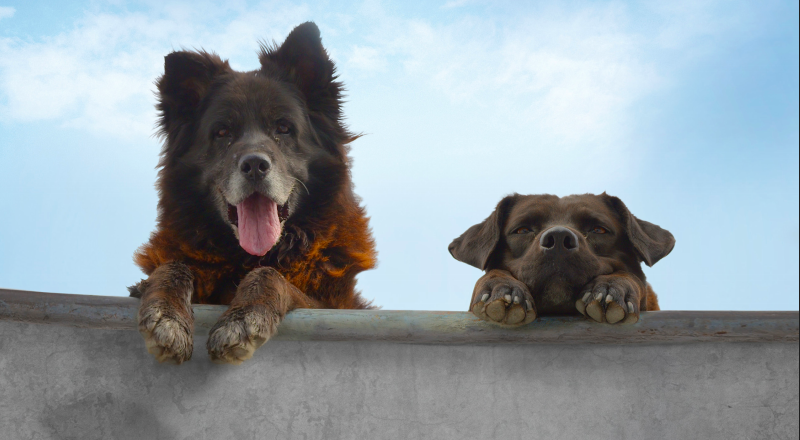INTERVIEW: Two street dogs are kings of ‘Los Reyes’ in Chile
Photo: Los Reyes follows the adventures of Chola and Fútbol, two street dogs, in a skatepark in Santiago, Chile. Photo courtesy of Cinema Tropical / Provided by Los Reyes press kit with permission.
Los Reyes, the new documentary by Bettina Perut and Iván Osnovikoff, follows two street dogs who hang out near the Los Reyes skatepark in Santiago, Chile. Their names are Chola and Fútbol, and the environs of the park are their domain.
It’s appropriate that the skatepark is called Los Reyes, which means the Kings in Spanish, because that’s exactly what these two dogs are when humans and other animals enter their living space.
“At first it was a skaters’ or teenagers skaters’ film because me, Iván, am a skateboarder and began to go to this skatepark and get very interested in the kind of conversations I had with them and what these conversations told about their relationship with their fathers, society, etc.,” Osnovikoff said in a recent phone interview. “We were very amazed about that subculture, but in time we began to get distance from making a traditional human-centered film and began to find a way to avoid this kind of approach. This was the moment when the dogs appeared.”
Perut said she was uneasy about focusing on the skaters for the entire length of the documentary. She wanted something more unconventional and different, and not just another human drama. When Chola and Fútbol entered the recording process, the filmmakers found their muses.
“I thought if we made a film about just skaters in the park and their stories, we would have been made a traditional film,” Perut said. “So when the dogs appeared, I thought, wow, this is the way we have to do it because with the dogs we could … discover a new world with a lot of cinematographic potential.”
Perut, who has worked extensively with Osnovikoff on such films as Welcome to New York and Surire, said it was not as difficult as one might think working with two animals.
“Working with dogs, it was not difficult because they always were free in their space, and they didn’t have problems with the camera,” she said. “We worked with them one whole year.”
Osnovikoff added: “The park was their territory. They weren’t passing by, so very shortly we understood the dynamics of their behaving in the park. So we knew when we arrived in the morning, they will go to the car, get some balls because we provided them the balls. Afterward they play a little with the balls and go find food and have naps, so we were very adaptive. … We were expecting always to have unexpected behavior, so we were ready to capture and record unexpected things. And the most beautiful sequences in the film are products of this, of being prepared for randomness.”
Throughout the film, as the viewer watches the dogs in their daily adventures, voiceovers of the skaters can be heard. Viewers are simultaneously introduced to the environment of the skatepark through the dogs’ eyes and receive some flavor of what draws people to this part of Santiago.
“The starting point for the project was these conversations, so when we decided to take out the human image from the film, we were always attached to those voices and stories,” Osnovikoff said. “For several reasons, we continued to keep the voices, and we found a way to integrate this kind of material with the observation of the dogs. We tried it, and we liked it. That’s why we worked that way.”
Perut cautioned audience members not to find too many parallels between the skaters and the dogs. They are in the same area on a regular basis, but these are two distinct stories. The directors are after reality, not necessarily metaphor.
“We didn’t necessarily make a parallel between human beings and dogs,” she said. “Obviously, there are relationships, and the nature of human beings are affected by the nature of dogs, and vice versa. But it’s not a real parallel … to say that the behavior of a human being is the same as the dog’s. Obviously some things overlap, but it’s not a parallel between human beings and dogs, or dogs between human beings.”
Eventually, the filmmakers realized their year with Chola and Fútbol was coming to an end. The narrative they were documenting was beginning to change, and their cameras were ready to be turned off.
“Things began to change in the park, and the new footage coming out of that, because of those changes, was not fitting with what we felt was the core of the material,” Osnovikoff said. “We knew there was this skate competition coming, and it’s done every year. But having in mind the painting of the park and the activities and the dynamics of that event, we were good.”
Perut added: “We had enough material. We had all kinds of things to put in the movie, all kinds of movement, all kinds of action.”
Most of that action was of the four-legged variety.
By John Soltes / Publisher / John@HollywoodSoapbox.com
Los Reyes, directed by Bettina Perut and Iván Osnovikoff, played as part of the Film Comment Selects series at the Film Society of Lincoln Center in New York City and the Miami International Film Fest. It won a Special Jury Award at the International Documentary Film Festival Amsterdam. Click here for more information.

